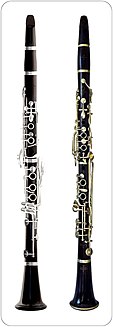Clarinet: Any unspecified or undetermined member of the clarinet family
The clarinet is a woodwind instrument.

 a Boehm clarinet and an Albert clarinet | |
| Woodwind instrument | |
|---|---|
| Classification | Woodwind |
| Playing range | |
 | |
The clarinet body is made up of the mouthpiece, barrel, upper joint, pads, keys, ring key, rod, lower joint, and bell. The clarinet has one reed. The reed is made of cane, bamboo or plastic, which varies in thickness. The reed is attached to the mouthpiece with a clamp called a ligature, which is usually made out of metal. Blowing through the mouthpiece makes the reed vibrate, and therefore makes the noise. The body of the clarinet is a cylindrical tube with holes. The holes are covered by the fingers to make musical notes. There are also buttons pressed by the fingers which allow pads over holes to open or close so all notes of the chromatic scale can be played. The buttons are usually played with the "pinkie" finger.
One kind of keyed clarinet is called the Albert system. Another kind is called the Boehm system. The Boehm clarinet is much used by classical orchestras and by jazz musicians. In North America and other Western countries, the most popular clarinet is the clarinet pitched in B flat. This means that if a clarinet player plays a note that is written as a C, it sounds like a B flat on a piano. The B flat clarinet is used in concert, marching, and school bands. Musicians in orchestras also play the A-clarinet (a semitone lower), the sopranino E flat clarinet (a fourth higher) and the Bass_clarinet in B flat (sounding an octave lower).
A beginner clarinet player usually can play a note within the first minutes of a lesson. Making a sound with the clarinet is easier than making a sound with many other wind instruments. Most instrumental music teachers consider it to be a good instrument for young players as soon as the lower adult teeth have grown. The fingering system is very similar to the flute and the saxophone, so changing from playing the clarinet to one of these instruments is not too difficult after the student is comfortable playing the clarinet and has reached a certain level.
A famous piece that features a clarinet is Wolfgang Amadeus Mozart's Clarinet Concerto, which has the clarinet playing the melody with the rest of the orchestra playing along. Written in 1791, it is often considered the first great composition for the instrument.
Components
Notable players
- Benny Goodman
- Artie Shaw
- Sabine Meyer
- Martin Fröst
- Charles Neidich
- Paul Meyer (clarinetist)
- Jörg Widmann
Other websites



This article uses material from the Wikipedia Simple English article Clarinet, which is released under the Creative Commons Attribution-ShareAlike 3.0 license ("CC BY-SA 3.0"); additional terms may apply (view authors). Content is available under CC BY-SA 4.0 unless otherwise noted. Images, videos and audio are available under their respective licenses.
®Wikipedia is a registered trademark of the Wiki Foundation, Inc. Wiki Simple English (DUHOCTRUNGQUOC.VN) is an independent company and has no affiliation with Wiki Foundation.



